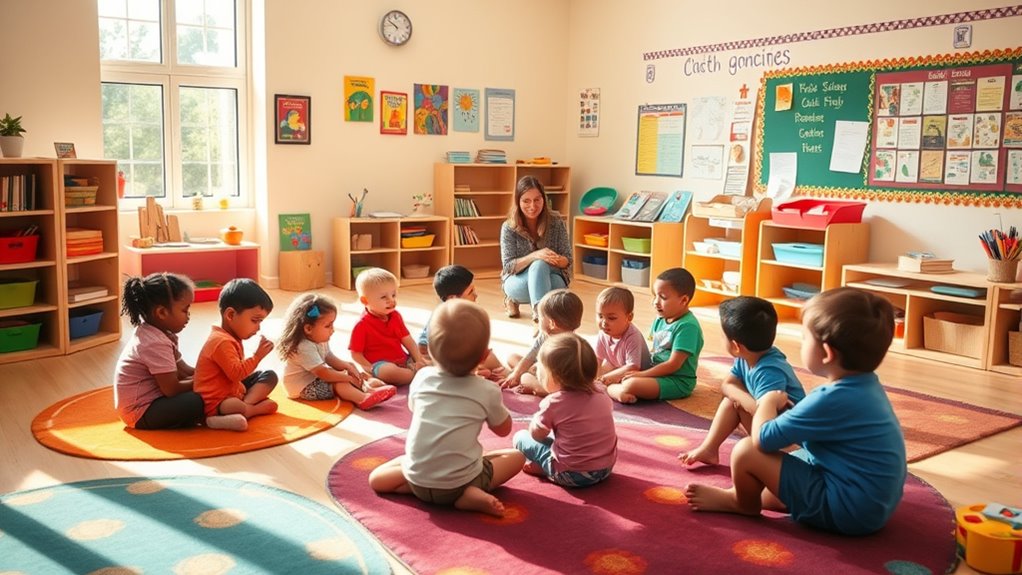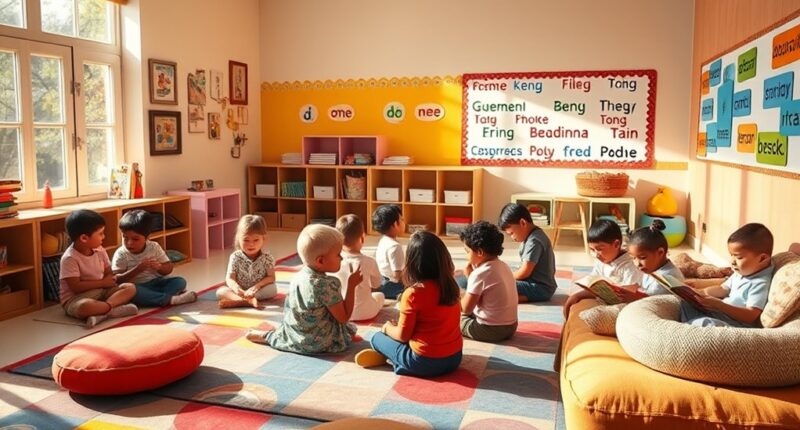Language nests are a vibrant preschool approach that helps revitalize endangered languages by immersing children in their native tongue from a young age. This model encourages daily use of the heritage language through stories, songs, and cultural activities, often involving elders and community members. By creating a natural environment for language learning, these programs foster cultural pride and identity. If you keep exploring, you’ll discover how these nests build resilient, culturally rich communities for future generations.
Key Takeaways
- Language nests immerse young children in their heritage language daily, promoting natural language acquisition and cultural continuity.
- They involve elders and fluent speakers to pass down stories, songs, and traditions alongside language instruction.
- Early childhood immersion fosters cultural pride, identity, and self-worth in indigenous and endangered language communities.
- Community participation ensures program sustainability, making language revitalization more resilient across generations.
- These preschool models effectively reverse language decline and support the preservation of cultural heritage through early education.

Across the globe, many indigenous and minority languages are disappearing at an alarming rate, but a growing movement is proving that early childhood education can revive these tongues. You might wonder how young children can play a essential role in preserving languages that are at risk of extinction. The answer lies in innovative models like language nests, which integrate language revitalization and cultural preservation into early education. These programs focus on immersing children in their native language from a very young age, ensuring that linguistic skills are passed down naturally and effectively. By doing so, they not only teach a language but also reinforce the cultural identity tied to it, making language revival a holistic process.
When you participate in a language nest, you become part of a community effort to keep a language alive. You help create an environment where children can hear and speak their ancestral language daily, fostering fluency and confidence. This immersion approach is essential because it addresses the natural way children learn languages—through consistent, contextual use. As a result, language revitalization becomes more than just a preservation project; it evolves into a living, breathing part of daily life. These programs often involve elders and fluent speakers, who act as cultural custodians, passing down stories, songs, and traditions alongside language instruction. This exchange strengthens both the language and cultural bonds, making the preservation effort more resilient and meaningful.
You’ll see that language nests aren’t just about vocabulary and grammar—they’re about nurturing cultural pride and identity. When children grow up speaking their heritage language, they carry their history, values, and traditions with them. This fosters a sense of belonging and self-worth, essential elements for cultural preservation. Additionally, early childhood is the optimal time to instill these linguistic and cultural roots because young minds are most receptive. By investing in language nests, you’re helping to reverse the decline of endangered languages, ensuring they survive for future generations. It’s a proactive approach that recognizes how fundamental language is to cultural continuity and how early education can be a powerful tool for language revitalization. Ultimately, these programs are about more than saving words—they’re about safeguarding identities and building resilient communities rooted in their ancestral languages.
Research shows that the effectiveness of these programs depends heavily on cultural immersion, which enhances the natural language learning process.
Frequently Asked Questions
How Do Language Nests Impact Children’s Academic Achievement Long-Term?
You might wonder how language nests influence children’s long-term academic achievement. By fostering cultural preservation and encouraging community engagement, these programs help children stay connected to their roots, boosting their confidence and identity. This strong cultural foundation can lead to better school performance, improved communication skills, and a sense of belonging. Over time, this holistic approach supports their academic success and helps sustain their heritage for future generations.
Are Language Nests Effective for Adult Language Revitalization?
Imagine you’re in the age of the Renaissance, reviving lost art—this mirrors how language nests work for adults. They’re effective because they boost language proficiency and foster community engagement. By immersing adults in the language, these nests help restore fluency and cultural ties, proving that dedicated, immersive environments can revitalise even long-dormant languages. You’ll find that they’re a powerful tool for cultural renewal and language preservation.
What Training Do Teachers Need to Run Language Nest Programs?
You need specialized training to run language nest programs, focusing on cultural integration and curriculum development. You’ll learn how to create immersive language experiences that honor traditions and incorporate cultural practices. Training should also cover effective teaching methods, community engagement, and ways to foster a supportive environment for both children and families. This prepares you to sustain language revitalization efforts while respecting cultural nuances, ensuring the program’s success and longevity.
How Are Language Nests Funded and Sustained Financially?
You might think funding is endless, but securing it often involves diverse sources like government grants, community donations, and partnerships. Ironically, program sustainability depends on continuous support, which isn’t guaranteed. You actively seek grants, build community backing, and demonstrate impact to keep the funds flowing. Understanding these funding sources and fostering ongoing support are essential for ensuring your language nest remains vibrant and thriving over time.
Can Language Nests Be Adapted for Urban or Diverse Communities?
You can adapt language nests for urban and diverse communities by incorporating local cultures and languages into daily activities. Focus on creating inclusive environments that respect cultural diversity, and involve community members to strengthen connections. Urban adaptation requires flexible spaces and resources that reflect the community’s unique identity, ensuring children feel proud of their heritage. This approach promotes language revitalization and cultural preservation within diverse urban settings.
Conclusion
By immersing children in their native languages, you help revive endangered tongues and foster cultural pride. Did you know that in some communities, language revival programs have increased fluency rates by over 40% in just a few years? By supporting models like Language Nests, you play a crucial role in ensuring these languages thrive for generations to come. Every child you teach becomes an essential part of preserving a rich cultural heritage and breathing new life into a disappearing language.
Mary is a passionate writer who brings creativity and a fresh perspective to our team. Her words have the power to captivate and inspire, making her an essential contributor to our content. Mary’s commitment to storytelling and dedication to promoting Indigenous culture ensures that her work touches the hearts of our readers. We’re fortunate to have her as part of our team.










